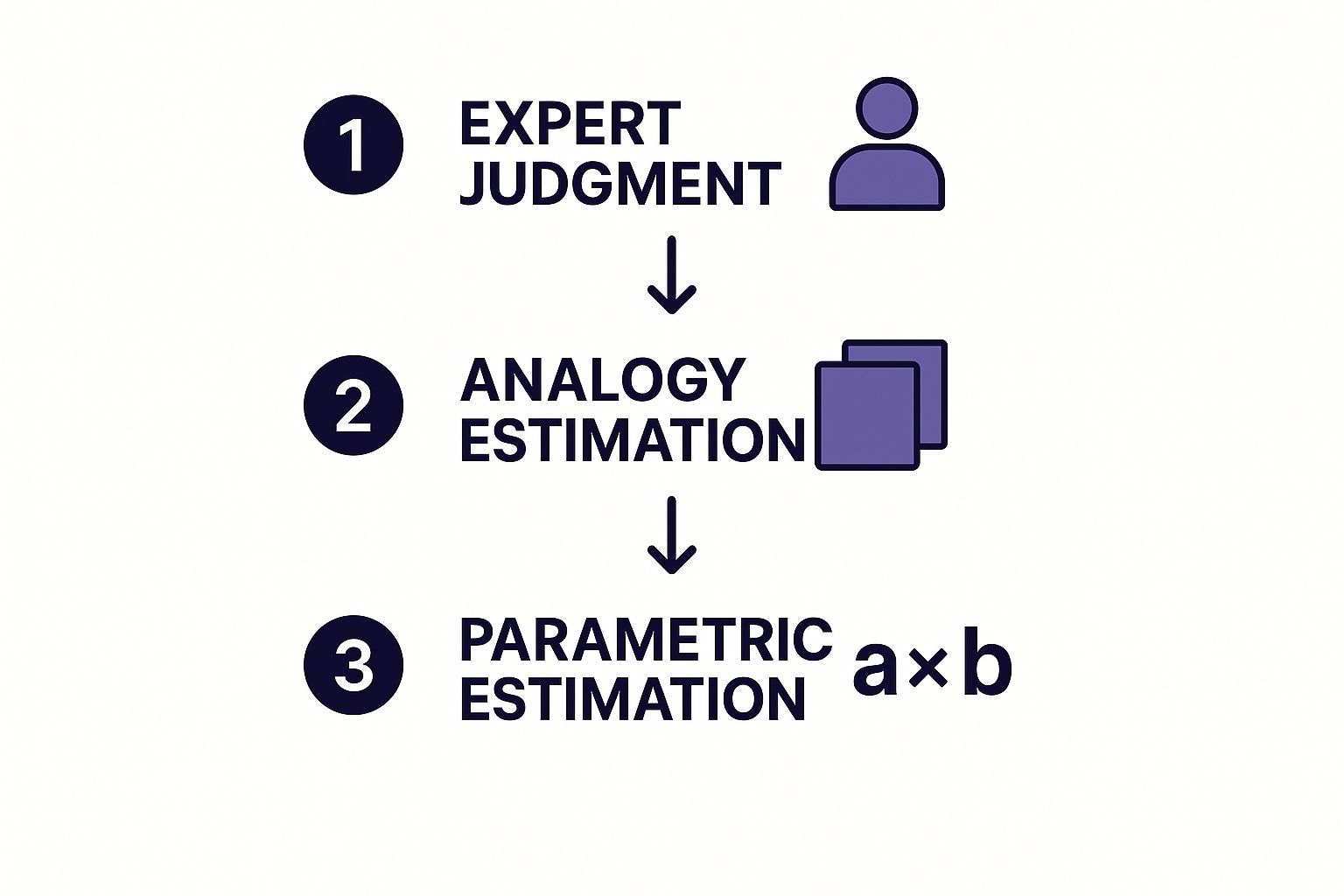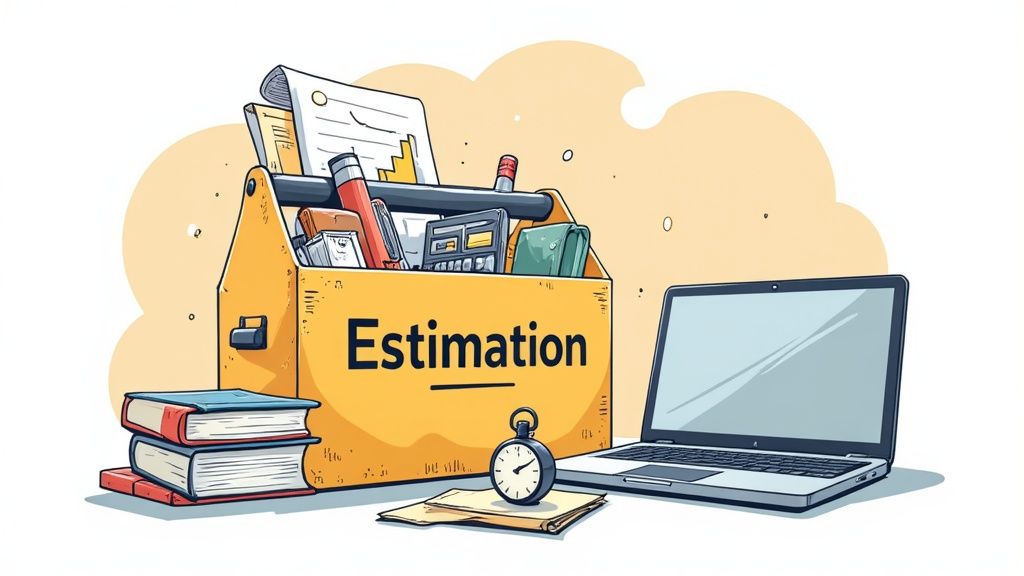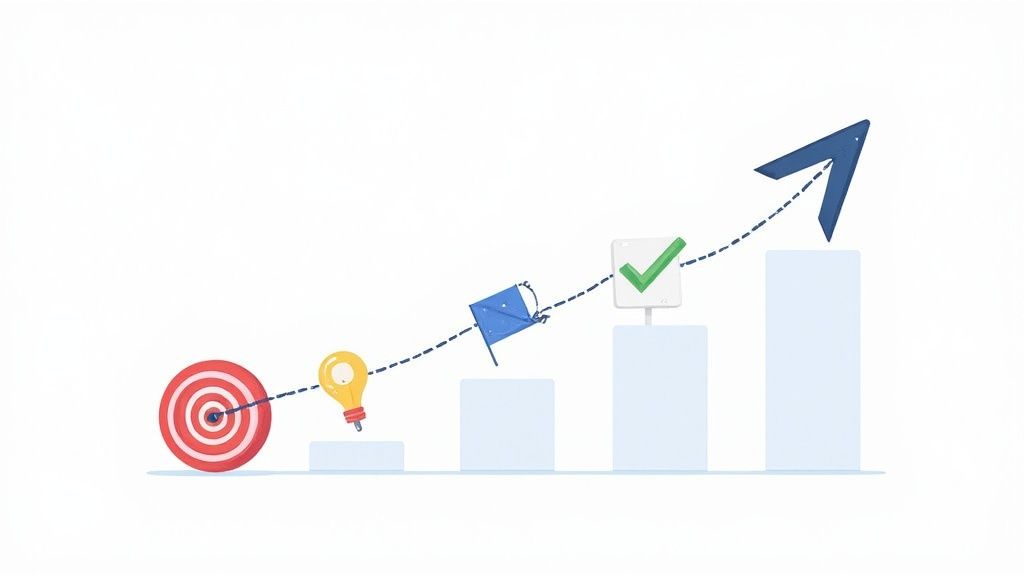
It always starts with a simple, almost innocent question from a client or stakeholder: "So, how much is this going to cost?"
If you have ever been on the receiving end of that question, you know it's a minefield. Answering it feels less like a calculation and more like trying to predict the future, often with the same accuracy as a weather forecast a month out. I've been there, and the sweat is real.
Software development cost estimation is the messy but critical process of figuring out the time, money, and sheer effort needed to get a project over the finish line. It's where business goals have a head on collision with technical realities. And it is notoriously difficult.
Why Is This The Hardest Question In Tech?
I once had a project where a seemingly simple feature request for a "smart" notification system spiraled into a budget nightmare. We thought we had it all figured out. What we didn't account for were the "unknown unknowns", the subtle complexities of integrating with three legacy APIs, each with its own quirks and undocumented behaviors. Our initial estimate, which seemed perfectly reasonable at the time, was blown completely out of the water. We learned a humbling lesson that week.
This experience is far from unique. Trying to estimate a software project can feel more like navigating a dense, unexplored jungle than building from a precise blueprint. Unlike constructing a building where materials and processes are standardized, software is intangible and dynamic. You aren't just assembling parts; you're creating logic from scratch.
A software estimate is the most important lie in a project's life. It is the number everyone remembers, even after the reasons for its inaccuracy are long forgotten.
This shared struggle is what makes software estimation so universally difficult. It's a constant battle against uncertainty, where requirements shift, assumptions are proven wrong, and unexpected technical hurdles appear out of nowhere. Getting this right is absolutely crucial for your business and your team's sanity. For any founder, understanding this reality is one of the most essential things to know before starting a startup.
From Lines of Code to Complex Models
The discipline of trying to tame this beast is not new. We have been trying to predict project effort since the 1950s and 60s. The early methods were pretty basic, often relying on simple metrics like Source Lines of Code (SLOC). It was a decent start, but it was like judging a book by the number of pages.
Over the decades, these evolved into more sophisticated models to support critical business needs like budgeting and risk management. A major milestone was the Constructive Cost Model (COCOMO) in the 1980s, which brought a more formulaic, data driven approach to the table.
Today, we have moved well beyond just counting lines of code. We now use a mix of complex models and agile techniques to navigate the uncertainty. This article is your guide through that jungle. We'll unpack the methodologies, expose the hidden cost drivers, and give you a practical playbook for building estimates you can actually stand behind.
Navigating Your Estimation Toolkit
Let's be clear: there is no silver bullet for perfect software development cost estimation. If someone tells you they have a magic formula, you should be skeptical. A better way to think about it is like a well stocked toolkit. You have different tools for different jobs, and an experienced pro knows exactly which one to grab and when.
This isn't just a list of dry definitions. I want to walk you through the most common methodologies I have actually used in the field, from classic algorithmic models to the more fluid, collaborative techniques that define the agile world. The goal here is to demystify these approaches and show you what they really are: practical aids, not rigid doctrines. Before we go deeper, here's what you should have in mind: diving into effective methods for estimating software project timelines can give you a broader perspective on the strategies available before we dig into the specifics of costing.
At a high level, estimation really boils down to three fundamental approaches: leaning on seasoned expertise, drawing comparisons to past work, or using mathematical formulas.

As the visual shows, your approach can be as simple as asking an expert or as complex as applying a parametric model. It all depends on what the project needs at that moment.
Top Down Estimation: The Art of the Big Picture
Top down estimation is like sketching the outline of a drawing before filling in the details. It's fast, requires less specific information, and is absolutely perfect for those early stages when you're just trying to figure out if a project is even feasible.
I remember a client who came to us with a brilliant but vague idea for a new fintech app. They needed a ballpark number for their investors, and they needed it yesterday. A detailed, bottom up estimate would have taken weeks we did not have.
So, we used a top down approach instead.
- Expert Judgment: We pulled our senior developers and architects into a room. Based on their collective experience with similar systems, they provided a rough but informed guess. Think of it as a highly educated gut feeling.
- Analogous Estimation: I personally thought back to a slightly smaller project we had completed a year prior. We took its final cost and adjusted it upwards by 20% to account for the new project's added complexity. This gave us a defensible starting point for the conversation.
Top down estimation is your best friend when ambiguity is high and time is short. It's not about precision; it's about establishing a reasonable budget range to get the ball rolling.
This method saved the day. It gave the client the number they needed for their pitch deck without getting bogged down in details that simply did not exist yet. It's a classic tradeoff: you sacrifice accuracy for speed.
Bottom Up Estimation: Winning with Details
Now, let's flip the script. Imagine you're about to sign a fixed bid contract. The client has agreed to pay a specific amount, and not a penny more. In this scenario, a top down guess is a recipe for disaster. You need precision. You need a bottom up estimate.
This is the meticulous, detail oriented approach where you break the entire project down into the smallest possible tasks.
Here's how it works in practice:
- Work Breakdown Structure (WBS): First, you create a WBS, which is just a fancy term for a hierarchical list of every single feature, sub feature, and task required. Think of it as the project's DNA.
- Task Estimation: Each individual task is then estimated by the person who will likely do the work. A developer might say, "The user login endpoint will take me 8 hours," and "The password reset form will take 6 hours."
- Aggregation: Finally, you add up the estimates for all these tiny tasks to get your grand total. From there, you add a contingency buffer to account for risks and unknowns.
A few years ago, we worked on a government project with incredibly strict budget controls. A bottom up estimate was non negotiable. It took our team nearly a full week to build the WBS and estimate every single task, but that detailed plan became our project bible. It was the only way we could confidently commit to a fixed price.
Agile Estimation: Embracing the Unknown
Both top down and bottom up models often assume a static, well defined scope. But what happens in the real world of agile development, where change is not just expected but welcomed?
This is where agile estimation techniques like story points and planning poker really shine. Instead of estimating in hours—which can be notoriously misleading—agile teams estimate the relative effort and complexity of the work.
- Story Points: A story point is an abstract unit of measure. It's a single number that accounts for the complexity, risk, and effort involved in a user story. A simple "change button color" task might be a 1 point story, while "integrate a new payment gateway" could be an 8 or even a 13.
- Planning Poker: This is a fun, collaborative exercise where team members use numbered cards to vote on the story point value for a task. It's a fantastic way to surface different perspectives and quickly build consensus around the effort involved.
The beauty of agile estimation is that it acknowledges we can't know everything up front. It's a system designed for learning and adapting. The team's "velocity"—the number of story points they complete per sprint—becomes a reliable predictor of future work, allowing for data driven forecasting without the false precision of hourly estimates.
Comparing Popular Estimation Methodologies
Let's pause and reflect. Choosing the right tool for the job is half the battle. This table breaks down the methodologies we have discussed, giving you a quick reference for when and how to use each one.
| Methodology | Best For | Pros | Cons |
|---|---|---|---|
| Top Down (Analogous/Expert) | Early stage projects, quick ballpark figures, feasibility studies. | Fast to create, requires minimal detail, good for strategic planning. | Lacks accuracy, relies heavily on experience, risky for fixed bids. |
| Bottom Up (WBS) | Fixed price contracts, projects with well defined scope, when high accuracy is required. | Highly detailed and accurate, creates a clear project plan, improves accountability. | Time consuming, requires a mature scope, can be inflexible to change. |
| Agile (Story Points) | Iterative development (Scrum/Kanban), projects with evolving requirements. | Adapts to change, fosters team collaboration, focuses on relative effort over time. | Can be abstract for stakeholders, velocity takes time to stabilize. |
Ultimately, the best approach often involves a mix of these techniques. You might start with a top down estimate to secure initial funding, then transition to a detailed bottom up plan for the first phase, and finally adopt agile estimation as development gets underway. Being flexible is key.
The Hidden Cost Drivers That Wreck Budgets
An estimate is only as good as its inputs. It's easy to focus on the obvious stuff, like team size and project duration, but the real budget busters are the complexities lurking just beneath the surface. These are the things that never show up on a feature list but can quietly double your timeline.

This meme is painfully accurate for so many software projects. The plan looks simple and serene on top, but underneath, a chaotic mess of dependencies and unexpected work is doing all the real paddling. Let's dive into these hidden drivers that can completely wreck your careful software development cost estimation.
The Treachery Of The Tech Stack
Choosing your technology stack feels like a purely technical decision, but it has massive financial implications. It's not about picking the "best" framework; it's about choosing the most productive one for your specific team and timeline.
I was once on a team that chose a brand new, cutting edge JavaScript framework for a big project. It promised incredible performance and a revolutionary way of working. The problem? It was so new that the documentation was thin, community support was non existent, and we kept hitting obscure bugs no one had ever seen before. I spent two full days on a bug that turned out to be a one line fix, but finding that one line was like searching for a needle in a haystack.
The result? Our development time ballooned by a staggering 20%. We spent weeks wrestling with the tool itself instead of actually building features. The lesson was painful but crystal clear: innovation sometimes comes with a "pioneer tax" in the form of unforeseen delays and brutal learning curves.
The Ghost In The Machine: Non Functional Requirements
Non functional requirements (NFRs) are the ghosts in your project's machine. They're the critical qualities of a system—performance, security, scalability—that are not tied to a specific feature, and they are incredibly easy to overlook during the initial estimate.
These are the questions you have to ask:
- Security: How will you handle authentication, data encryption, and protect against common vulnerabilities? A simple login form is one thing; a secure, production grade authentication system is a completely different beast.
- Scalability: Will this system need to support 100 users or 100,000? The architectural decisions required to handle a massive user load are fundamentally different and far more expensive to build.
- Performance: What's an acceptable response time for your API? Shaving a few milliseconds off a query might require extensive database optimization and complex caching strategies that you never budgeted for.
I saw a project where the team built a fantastic MVP but completely ignored scalability. When their user base exploded unexpectedly, the system ground to a halt. The refactoring effort that followed was not only expensive but also delayed their product roadmap for an entire quarter. These hidden requirements often surface during a thorough technical audit; you can learn more by exploring a technical due diligence checklist for your next project.
The Domino Effect Of Third Party Integrations
Modern software is rarely built in a vacuum. We rely on a web of third party APIs for everything from payment processing with Stripe to sending emails with SendGrid. While these integrations save us from reinventing the wheel, they also introduce significant dependencies and risks.
Each integration is a potential point of failure. You're completely at the mercy of another company's documentation (or lack thereof), their system's uptime, and their API's rate limits. A poorly documented API can easily turn a task you estimated at four hours into a four day investigation.
The industry stats back this up. Nearly 70% of software projects exceed their initial budgets, with ambiguous requirements and poor risk management being major culprits. For example, in 2023, about 47% of ERP implementations—which are notorious for their integration complexity—faced budget overruns. This just hammers home how crucial it is to map out every dependency and treat each integration like its own mini project with its own set of risks.
An estimate that ignores non functional requirements and third party dependencies is not an estimate; it's a guess. It's the difference between planning a road trip with a map versus just pointing your car in a general direction and hoping for the best.
By proactively identifying these hidden cost drivers, you can move from hopeful guessing to building a resilient, realistic budget that can withstand the inevitable surprises of software development.
Moving From Educated Guess To Data Driven Forecast
The best estimators I have ever worked with all had one thing in common. They learned from the past.
Relying on an experienced developer's "gut feeling" is often where estimation starts, but it's just not a scalable or repeatable process. To really nail your software development cost estimation, you have to make the leap from an educated guess to a data driven forecast. This is where we shift from institutional knowledge into the actual science of estimation. It's about turning a subjective art into a discipline that you can measure, refine, and improve project after project. The goal is simple: build a feedback loop where every finished project makes the next estimate that much sharper.
Starting Your Data Repository
You don't need a fancy, expensive system to get started. I have seen teams make huge leaps forward with nothing more than a shared spreadsheet. The initial goal is to just start tracking what you thought would happen versus what actually happened.
Here's a barebones way to begin building your own repository of project data:
- Task Description: A clear, one sentence summary of the work (e.g., "Build user authentication endpoint").
- Initial Estimate (Hours): The original number of hours you budgeted for the task.
- Actual Hours: The final number of hours it took to complete the task, including testing and any revisions.
- Variance: A simple calculation (Actual Initial) that shows the difference. A positive number means it took longer; a negative one means you finished early.
- Notes/Reasons for Variance: This is the most important column. Was the API documentation wrong? Did the requirements change mid sprint? Was a senior dev pulled onto another fire?
This simple act of recording creates an invaluable historical record. It forces you to confront reality and moves the conversation from "I feel like this will take two days" to "Tasks like this have historically taken us three days, even when they seem simple."
By the way, getting the inputs right is half the battle. You can learn more about the importance of solid inputs by reviewing our guide to testing software requirements before you even get to this stage.
Spotting Patterns And Refining Your Process
Once you have a few projects' worth of data, you can start looking for patterns.
Are you consistently underestimating backend tasks? Do tasks involving third party APIs always take 25% longer than you think? This data gives you the power to adjust your future estimates with real evidence to back you up.
This kind of data driven approach is quickly becoming the industry standard. We're seeing a major shift towards more scientific forecasting, where firms analyze historical cost data from systems like their ERPs and CRMs to generate initial estimates. This emergent trend is all about applying statistical methods to pinpoint cost drivers and quantify the relationship between project parameters and final expenses. You can discover more about how improving cost estimation with historical project data is changing the game.
Your past performance is the single best predictor of your future performance. Ignoring that data is like trying to navigate a city with a blank map. You might get there eventually, but it's going to be a long, inefficient journey.
This is not about placing blame when estimates are off. It's about collective learning. Maybe your team needs more training on a specific technology, or perhaps your process for defining requirements needs to be more rigorous. The data just points you toward the areas that need the most attention. It makes estimation an improvable discipline, not a one off dark art.
Your Playbook For Building A Defensible Estimate
We've covered the models, the theories, and all the hidden gremlins that love to blow up a software budget. Now it's time to get practical. Let's build an estimate you can actually stand behind, whether you're presenting it to a client, your boss, or a board of investors.
This is not just a numbers game. It's about building a narrative that explains why the final number is what it is. A solid estimate tells a story of careful planning, risk awareness, and a clear path from A to B.

Think of this as your guide to moving beyond a single, scary number. The goal is to present a comprehensive plan that builds trust and sets the right expectations from the get go.
Deconstructing The Vision With A WBS
First thing's first: you have to break down the big, ambitious project idea into small, digestible chunks. The absolute best tool for this is the Work Breakdown Structure (WBS). It sounds a bit formal, but it's really just a hierarchical list of every single thing that needs to get done.
I still remember a client who kept describing a new feature as a "simple user profile." When we actually sat down and built a WBS for it, "simple" suddenly turned into:
- Create user registration API endpoint.
- Design and build the registration form UI.
- Implement password hashing and security protocols.
- Develop the "Forgot Password" email flow.
- Build the "Edit Profile" screen.
- Add functionality for uploading a profile picture.
What was once a vague idea was now a concrete list of six distinct tasks. That's the magic of a WBS. It forces you to get specific and uncovers hidden work before it becomes a late night emergency. This is the bedrock of your entire cost estimation.
Applying Buffers The Smart Way
Once you have your task list, it's time to assign hours. But let's be real—things rarely go exactly to plan. That's where buffers, or contingency, come into play. The problem is, slapping a random 20% "padding" on the end of an estimate feels arbitrary and is almost impossible to defend.
A much better approach is to use risk based buffers.
Instead of a blanket percentage, go through each major part of your WBS and assign a risk level: low, medium, or high.
- Low Risk (5% Buffer): A task your team has done a dozen times, using familiar tech with crystal clear requirements.
- Medium Risk (15% Buffer): A task that involves a moderately complex new feature or integrating with a well documented third party API.
- High Risk (30%+ Buffer): A task that needs R&D, depends on a poorly documented external system, or involves a technology that's brand new to the team.
This simple shift changes your buffer from a vague "just in case" fund into a calculated risk management strategy. You can now confidently tell stakeholders, "We added a larger buffer to the payment integration because, in our experience, those APIs always have a few surprises."
An estimate is a living document, not a static calculation chiseled in stone. It is a snapshot of your understanding at a single point in time, and it must be allowed to evolve as that understanding deepens.
This method also makes your estimate dynamic. As you knock out high risk items and that risk evaporates, you can re evaluate your remaining contingency. It's a transparent process that keeps everyone in the loop.
The Art Of Communicating Your Estimate
The final, crucial step is the delivery. How you communicate the estimate is just as important as the math behind it. Please, never just email a spreadsheet with a number at the bottom.
Schedule a meeting. Walk stakeholders through your entire process. Show them the WBS. Point out the specific risks you've identified and explain how your targeted buffers account for them. I always recommend framing the estimate not as a single number but as a range—think best case, most likely, and worst case scenarios.
This approach builds a massive amount of trust and screams professionalism. It proves you've done your homework and are not just guessing. As you refine your process, incorporating proven ways to reduce software development costs can make your proposals even more compelling.
Here's a simplified table showing how you might break down the final numbers in a presentation.
Sample Cost Estimation Template Breakdown
This table gives a high level view of how different project components, including a risk based buffer, add up to the total estimated cost. We're using an example rate of $100/hour for simplicity.
| Component | Description | Estimated Hours | Cost (Example Rate) |
|---|---|---|---|
| Phase 1: Core Features | User Authentication, Dashboard, Core Logic | 120 | $12,000 |
| Phase 2: Integrations | Payment Gateway, Email Service | 80 | $8,000 |
| QA & Testing | Unit Tests, Integration Tests, UAT | 60 | $6,000 |
| Project Management | Planning, Meetings, Coordination | 40 | $4,000 |
| Subtotal | Total Estimated Direct Effort | 300 | $30,000 |
| Contingency Buffer | Calculated Risk (e.g., 15% average) | 45 | $4,500 |
| Grand Total | Estimated Project Cost Range | 345 | $34,500 |
This kind of breakdown makes the final number feel earned, not arbitrary. By following this playbook—deconstructing the work, applying smart buffers, and communicating transparently—you'll craft estimates that are not only more accurate but also build the foundation for a great project partnership.
We've walked through the models, uncovered the hidden costs, and laid out the playbooks. But even with the most buttoned up spreadsheet, some tough questions always manage to find their way into the conversation, usually right as you're presenting your numbers.
Let's tackle a few of the ones I hear most often from clients, managers, and even my own team.
How Can I Estimate a Project with an Undefined Scope?
Ah, the classic. The client has a killer vision, but the actual details are... fuzzy. Throwing out a single, concrete number at this stage is a recipe for disaster and broken promises down the line.
The only sane way to handle this is to provide a ranged estimate, something like "$50,000 to $75,000." You have to be crystal clear about the assumptions baked into that range. Frame it as a ballpark figure for initial budgeting, making it plain that a paid discovery phase is needed to sharpen the pencil. Precision follows clarity.
Another great tool I use is T shirt sizing (S, M, L, XL). It's a low pressure way to talk about the general scale of different features without getting bogged down in exact hours or dollar amounts too early.
What Is the Difference Between an Estimate and a Quote?
This is a big one, and the confusion can be costly. An estimate is your professional, educated guess about the likely cost. It's an approximation, and it's expected to change as you learn more.
A quote, on the other hand, is a fixed price, legally binding offer.
Once a client accepts a quote, you're locked in. It does not matter if you misjudged the effort or if your team takes twice as long; that's the price. You should only give a quote when the requirements are perfectly clear, fully documented, and signed off by everyone involved.
Treating an estimate like a quote is the fastest way to blow your budget and burn out your team. Communicating this difference from day one is not just a good idea; it's non negotiable.
Why Do Developer Hourly Rates Vary So Much?
This question pops up a lot, especially when a stakeholder gets sticker shock comparing bids from different vendors or looking at global talent. It really boils down to a few key factors:
- Geography and Cost of Living: It's simple economics. A developer in San Francisco has a massively different cost of living than someone in Eastern Europe or Southeast Asia, and their rates have to reflect that.
- Experience Level: You get what you pay for. A senior or principal engineer who can architect a complex system and mentor the team is going to command a much higher rate than a junior developer who is still learning the ropes. Their impact is just on a different scale.
- Technology Stack: Skills in high demand fetch a premium. If you need a specialist in a niche AI framework or a specific blockchain protocol, you're competing for a much smaller pool of talent, and the rates will show it.
How Do You Account for Scope Creep in an Initial Estimate?
You can't predict scope creep with a crystal ball, but you can absolutely plan for it. The best defense is a rock solid change control process that's clearly defined in your contract or statement of work. This process needs to spell out exactly how new requests are submitted, evaluated for impact, estimated, and approved before a single line of code is written.
In the estimate itself, it's standard practice to build in a contingency buffer—typically 10% to 20% of the total project cost. And let's be clear: this buffer is not a slush fund for sloppy planning or mistakes. It's a transparent line item allocated specifically for those unforeseen tasks or minor scope adjustments that everyone agrees are necessary along the way.
Are you an early stage startup looking to accelerate your roadmap and build a robust, scalable system? Kuldeep Pisda offers deep execution and thoughtful architecture for startups building with Django, GenAI, and modern full stack technologies. Strengthen your technical foundations and deliver with confidence by visiting https://kdpisda.in.
Become a subscriber receive the latest updates in your inbox.



Member discussion